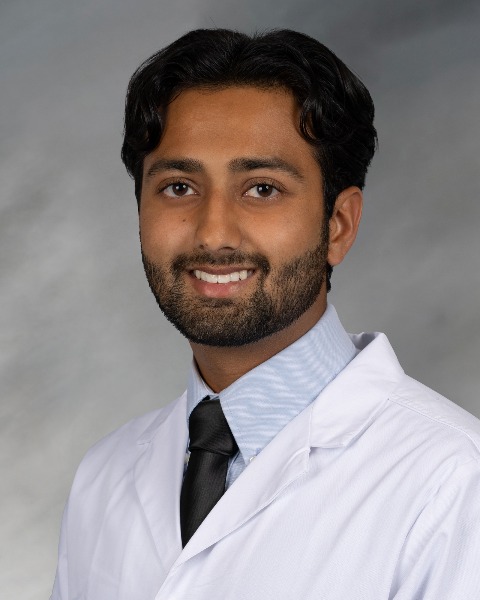Sunday Poster Session
Category: Liver
P1598 - Characterizing Hepatic Sarcoidosis: Disease Progression and Treatment Outcomes in a Tertiary Care Center
Sunday, October 26, 2025
3:30 PM - 7:00 PM PDT
Location: Exhibit Hall

Neil Garg, BS (he/him/his)
Wayne State University School of Medicine
Detroit, MI
Presenting Author(s)
Neil Garg, BS1, Muhammad Saad Faisal, MD2, Syed-Mohammed Jafri, MD2
1Wayne State University School of Medicine, Detroit, MI; 2Henry Ford Health, Detroit, MI
Introduction: Sarcoidosis is a multisystem granulomatous disease that frequently affects the lungs, lymph nodes, skin, eyes, and heart. Hepatic involvement is less common and often under-recognized, yet it may result in significant morbidity. This study aimed to describe the clinical characteristics, hepatic outcomes, treatment patterns, and hepatology involvement in patients with hepatic sarcoidosis at a single academic center.
Methods: We conducted a retrospective review of patients with sarcoidosis evaluated between 1990 and 2025. Inclusion criteria were elevated liver enzymes (AST or ALT > 60 IU/L) and radiologic features suggestive of cirrhosis. Patients with a history of solid organ transplantation were excluded. The primary outcome was diagnosis of hepatic sarcoidosis and the secondary outcome was all-cause mortality. Demographics, laboratory values, treatments, and hepatology referral were also analyzed.
Results: Of 101 patients with sarcoidosis, 10 (9.9%) met criteria for hepatic sarcoidosis. All 10 had multisystem involvement including ocular, cutaneous, lymphatic, pancreatic, splenic, cardiac, pulmonary, neurologic, and/or skeletal sarcoidosis. Median age at diagnosis was 55.5 years (IQR 45.5–67.5); 4 (40%) were male. Six (60%) were Black and 4 (40%) Caucasian. Treatments included prednisone (70%), methotrexate (50%), infliximab (30%), hydroxychloroquine (30%), adalimumab (20%), and azathioprine (10%). The median peak ALT, AST, ALP and total bilirubin were 103, 102 and 340.5 IU/mL, respectively. The median total bilirubin and serum albumin were 1 mg/dL and 3.4 g/dL. Median time from diagnosis to last follow up or death was 4.96 years. Of these 10 patients, two had cirrhosis with one developing portal hypertension complicated by ascites and esophageal varices. This patient died from gastrointestinal hemorrhage. None of these patients had a history of alcohol use disorder. Seven of these 10 patients with hepatic sarcoidosis were seen by hepatology.
Discussion: Hepatic sarcoidosis is an uncommon but potentially serious manifestation of sarcoidosis, occurring in 10% of the patients in our cohort. One patient died from liver-related complications. Despite significant hepatic involvement, only 70% received hepatology evaluation. The absence of alcohol use disorder suggests sarcoidosis as the primary etiology. These findings underscore the need for increased awareness, early detection, and routine hepatology referral in patients with suspected hepatic sarcoidosis.
Disclosures:
Neil Garg indicated no relevant financial relationships.
Muhammad Saad Faisal indicated no relevant financial relationships.
Syed-Mohammed Jafri: Abbvie – Speakers Bureau. Gilead – Speakers Bureau. Intercept – Speakers Bureau. Ironwood – Speakers Bureau. Takeda – Speakers Bureau.
Neil Garg, BS1, Muhammad Saad Faisal, MD2, Syed-Mohammed Jafri, MD2. P1598 - Characterizing Hepatic Sarcoidosis: Disease Progression and Treatment Outcomes in a Tertiary Care Center, ACG 2025 Annual Scientific Meeting Abstracts. Phoenix, AZ: American College of Gastroenterology.
1Wayne State University School of Medicine, Detroit, MI; 2Henry Ford Health, Detroit, MI
Introduction: Sarcoidosis is a multisystem granulomatous disease that frequently affects the lungs, lymph nodes, skin, eyes, and heart. Hepatic involvement is less common and often under-recognized, yet it may result in significant morbidity. This study aimed to describe the clinical characteristics, hepatic outcomes, treatment patterns, and hepatology involvement in patients with hepatic sarcoidosis at a single academic center.
Methods: We conducted a retrospective review of patients with sarcoidosis evaluated between 1990 and 2025. Inclusion criteria were elevated liver enzymes (AST or ALT > 60 IU/L) and radiologic features suggestive of cirrhosis. Patients with a history of solid organ transplantation were excluded. The primary outcome was diagnosis of hepatic sarcoidosis and the secondary outcome was all-cause mortality. Demographics, laboratory values, treatments, and hepatology referral were also analyzed.
Results: Of 101 patients with sarcoidosis, 10 (9.9%) met criteria for hepatic sarcoidosis. All 10 had multisystem involvement including ocular, cutaneous, lymphatic, pancreatic, splenic, cardiac, pulmonary, neurologic, and/or skeletal sarcoidosis. Median age at diagnosis was 55.5 years (IQR 45.5–67.5); 4 (40%) were male. Six (60%) were Black and 4 (40%) Caucasian. Treatments included prednisone (70%), methotrexate (50%), infliximab (30%), hydroxychloroquine (30%), adalimumab (20%), and azathioprine (10%). The median peak ALT, AST, ALP and total bilirubin were 103, 102 and 340.5 IU/mL, respectively. The median total bilirubin and serum albumin were 1 mg/dL and 3.4 g/dL. Median time from diagnosis to last follow up or death was 4.96 years. Of these 10 patients, two had cirrhosis with one developing portal hypertension complicated by ascites and esophageal varices. This patient died from gastrointestinal hemorrhage. None of these patients had a history of alcohol use disorder. Seven of these 10 patients with hepatic sarcoidosis were seen by hepatology.
Discussion: Hepatic sarcoidosis is an uncommon but potentially serious manifestation of sarcoidosis, occurring in 10% of the patients in our cohort. One patient died from liver-related complications. Despite significant hepatic involvement, only 70% received hepatology evaluation. The absence of alcohol use disorder suggests sarcoidosis as the primary etiology. These findings underscore the need for increased awareness, early detection, and routine hepatology referral in patients with suspected hepatic sarcoidosis.
Disclosures:
Neil Garg indicated no relevant financial relationships.
Muhammad Saad Faisal indicated no relevant financial relationships.
Syed-Mohammed Jafri: Abbvie – Speakers Bureau. Gilead – Speakers Bureau. Intercept – Speakers Bureau. Ironwood – Speakers Bureau. Takeda – Speakers Bureau.
Neil Garg, BS1, Muhammad Saad Faisal, MD2, Syed-Mohammed Jafri, MD2. P1598 - Characterizing Hepatic Sarcoidosis: Disease Progression and Treatment Outcomes in a Tertiary Care Center, ACG 2025 Annual Scientific Meeting Abstracts. Phoenix, AZ: American College of Gastroenterology.
